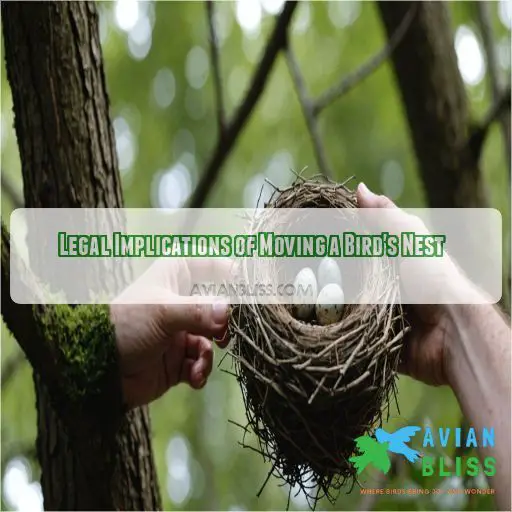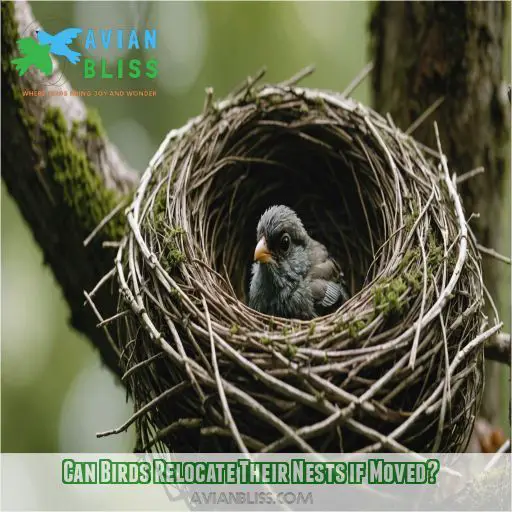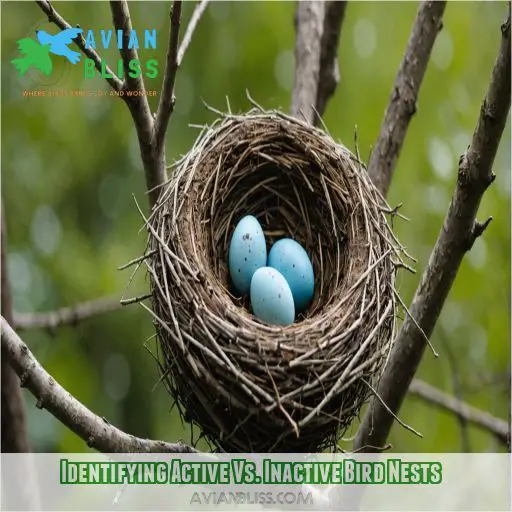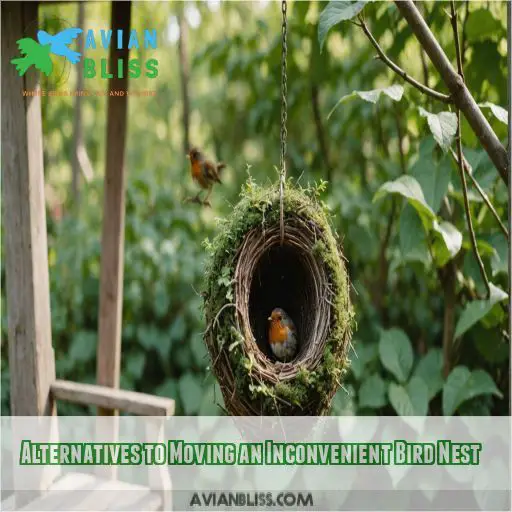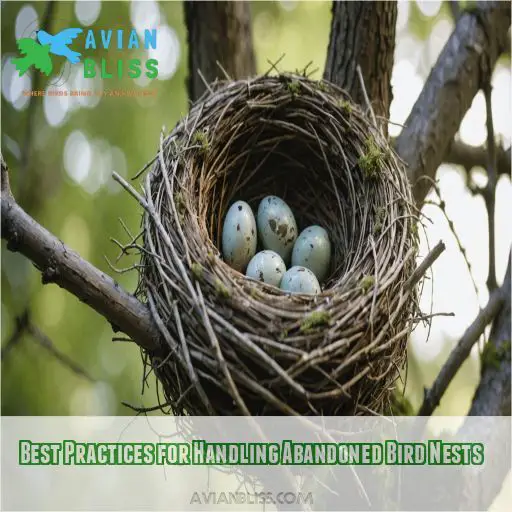This site is supported by our readers. We may earn a commission, at no cost to you, if you purchase through links.
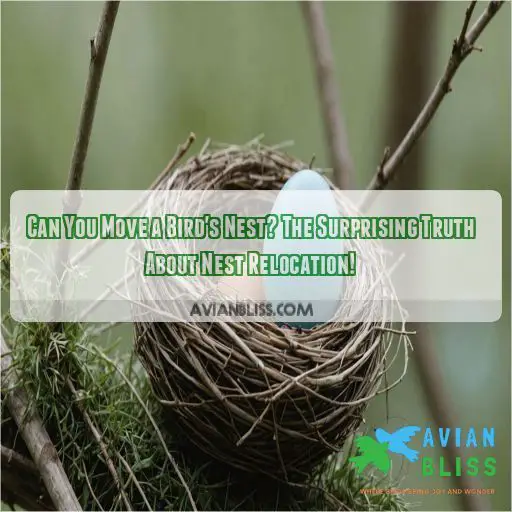
You might think you’re doing the birds a favor, but trust me, they’ve got their own GPS system!
The Migratory Bird Treaty Act protects most nests, so you could ruffle some legal feathers if you interfere.
Birds are creatures of habit, and relocating their home sweet home can cause serious stress.
They might even abandon ship, leaving their eggs or chicks high and dry.
If you’re dealing with a problematic nest, don’t wing it!
There are bird-friendly alternatives that’ll keep both you and your feathered friends happy.
Ready to explore some nest-savvy solutions?
Table Of Contents
- Key Takeaways
- Legal Implications of Moving a Bird’s Nest
- Can Birds Relocate Their Nests if Moved?
- Identifying Active Vs. Inactive Bird Nests
- Alternatives to Moving an Inconvenient Bird Nest
- Safety Concerns: When Nest Removal is Necessary
- Best Practices for Handling Abandoned Bird Nests
- Impact of Human Interaction on Nesting Birds
- Conservation Efforts and Protecting Bird Habitats
- Frequently Asked Questions (FAQs)
- Can birds find their nest if moved?
- In what states is it illegal to move a bird’s nest?
- Will a mother bird come back if you touch her nest?
- What happens if you disturb a bird’s nest?
- How long does it take birds to build a nest?
- Can birds reuse nests from previous seasons?
- Do all bird species build nests in trees?
- What materials do birds typically use for nest-building?
- How do weather conditions affect bird nesting behavior?
- Conclusion
Key Takeaways
- Moving a bird’s nest is like trying to relocate the Eiffel Tower – it’s a no-go! The Migratory Bird Treaty Act protects most nests, so you could end up in hot water if you play nest musical chairs.
- Birds are homebodies with built-in GPS. Relocating their cozy abodes can ruffle their feathers, causing stress and potential abandonment. It’s like suddenly waking up to find your house on the other side of town!
- Before you go all "bird landlord" on an inconvenient nest, explore bird-friendly alternatives. Think of it as diplomacy with your feathered neighbors – temporary barriers, tweaking your routine, or creating alternative nesting sites can keep everyone chirping happily.
- If safety concerns have you in a flap, don’t wing it alone! Seek professional wildlife management assistance. They’re the avian real estate experts who can help you navigate the fine line between human needs and bird rights.
Legal Implications of Moving a Bird’s Nest
You might think moving a bird’s nest is no big deal, but it’s actually a legal minefield. The Migratory Bird Treaty Act and various state laws make it illegal to disturb most bird nests, with hefty penalties for those who break the rules.
Migratory Bird Treaty Act (MBTA) Protections
Ever thought about moving a bird’s nest? Hold your horses! The Migratory Bird Treaty Act (MBTA) is like a feathered fortress, protecting most nests from human meddling. It’s not just a slap on the wrist – MBTA penalties can ruffle your feathers if you’re caught disturbing these avian abodes.
State-specific Laws and Regulations
While federal laws protect most bird nests, state regulations can add extra layers of complexity. You’ll want to brush up on your local rules before even thinking about moving a nest. Here’s a quick rundown of what you might encounter:
- Stricter protection periods
- Additional protected species
- Heftier fines for violations
- Specific permit requirements
Exceptions for Non-native Bird Species
While most birds are protected, there’s a plot twist! Non-native species like European starlings and English sparrows aren’t covered by the MBTA. This means you’ve got more wiggle room when dealing with their nests. But don’t jump the gun—getting the species right is super important before taking action.
Penalties for Illegal Nest Removal
You might think moving a bird’s nest is no big deal, but it can land you in hot water! Illegal nest removal carries serious penalties that’ll make you think twice:
- Hefty fines that’ll ruffle your feathers
- Possible jail time (talk about being caged!)
- Contributing to bird population decline
- Damaging important habitats
- Undermining conservation efforts
Can Birds Relocate Their Nests if Moved?
You might be wondering if you can simply move a bird’s nest to a more convenient spot. While it’s tempting to relocate a nest that’s in your way, the reality is that birds don’t typically take kindly to having their homes uprooted.
Impact on Bird Behavior and Nesting Patterns
When you move a bird’s nest, you’re not just relocating twigs and grass – you’re shaking up an entire avian household! Let’s peek into the fascinating world of bird behavior when their cozy homes get the "relocation treatment":
| Bird Reaction | Human Equivalent |
|---|---|
| Confusion | "Where’s my house?" |
| Stress | "I need a vacation!" |
| Abandonment | "I’m outta here!" |
| Adaptability | "Let’s make this work" |
| Resilience | "Home is where the heart is" |
Factors Affecting Nest Relocation Success
While bird behavior varies, several factors influence nest relocation success:
- Nestling age: Younger birds adapt better
- Timing: Avoid peak breeding season
- Habitat similarity: New spot should match original
Potential Consequences for Bird Populations
Beyond individual nests, moving them can spell trouble for entire bird populations. You might be unwittingly contributing to nest abandonment, population decline, and increased predation. It’s like playing Jenga with nature – one wrong move, and the whole ecosystem could tumble down.
Scientific Studies on Nest Relocation
You might be surprised to learn that scientific studies on bird nest relocation are few and far between. Researchers face ethical hurdles when studying this topic, as moving nests can stress birds and impact populations. The limited data available suggests relocation success rates vary widely among species.
Identifying Active Vs. Inactive Bird Nests
Ever wondered if that nest in your backyard is still in use? Knowing how to spot an active bird nest isn’t just fascinating – it’s important if you’re considering any changes to your outdoor space. Let’s explore the telltale signs that’ll help you become a nest detective and make sure you’re not accidentally disturbing our feathered friends’ homes.
Signs of an Active Nest
Spotting an active bird nest isn’t rocket science! Keep your eyes peeled for these telltale signs:
- Fresh nesting materials being added
- Birds coming and going frequently
- Constant chirping or other vocalizations
Seasonal Nesting Patterns
Ever wondered when birds are most likely to nest? Here’s a handy seasonal guide to keep you in the loop:
| Season | Nesting Activity |
|---|---|
| Spring | Peak time |
| Summer | Slowing down |
| Fall | Rare occurences |
| Winter | Mostly inactive |
Common Nesting Locations
Now that you know when birds nest, let’s explore where they set up shop. Birds are nature’s architects, building homes in surprising places. Here are some common nesting spots you might encounter:
- Trees and shrubs
- Building eaves and gutters
- Birdhouses and nest boxes
- Ground-level vegetation
Differentiating Between Species-specific Nests
You’re a bird detective now! Identifying nests is like solving a feathery puzzle. Each species has its own style, from tiny cups to massive platforms. Let’s break it down:
| Nest Type | Size | Common Materials |
|---|---|---|
| Cup | Small | Grass, twigs |
| Platform | Large | Sticks, leaves |
| Cavity | Varies | Wood chips |
| Pendant | Long | Plant fibers |
Alternatives to Moving an Inconvenient Bird Nest
Finding a bird’s nest in an inconvenient spot can be a real head-scratcher, but don’t worry – you’ve got options! Before you even think about moving that nest, let’s explore some clever alternatives that’ll keep both you and your feathered neighbors happy.
Temporary Barriers and Deterrents
Now that you’re a pro at spotting active nests, let’s talk about keeping birds at bay without ruffling any feathers. Temporary barriers and deterrents are your secret weapons! These bird-friendly solutions can help you reclaim your space while respecting our feathered friends’ need for a cozy home.
Modifying Human Behavior to Accommodate Nests
While barriers can help, sometimes it’s best to adjust your own routine. Think of it as a chance to coexist with nature! By tweaking your daily habits, you can give those feathered families the space they need without ruffling any feathers yourself.
Creating Alternative Nesting Sites
- Install strategically placed birdhouses
- Offer nesting materials like twigs and moss
- Plant native shrubs for natural nesting sites
It’s like giving birds their own cozy Airbnb!
Seeking Professional Wildlife Management Assistance
If DIY solutions aren’t cutting it, don’t wing it alone! Professional wildlife managers are your ace in the hole. They’re experts at bird damage prevention and can offer specific advice on wildlife conflict resolution. While it might ruffle your feathers, their services are worth every penny for responsible nest management.
Safety Concerns: When Nest Removal is Necessary
While it’s generally not advisable to move a bird’s nest, there are some situations where safety concerns make removal necessary. From health hazards to structural damage, let’s explore the circumstances that might warrant nest relocation and the proper steps to take if you find yourself in this tricky situation.
Health Hazards Associated With Bird Nests
While bird nests can be charming, they’re not always harmless. You might face some unexpected health risks, like bird mites that can invade your home or diseases like Histoplasmosis from droppings. It’s not all doom and gloom, but it’s worth knowing the potential issues before you become an unwitting bird landlord!
Structural Damage to Buildings
While birds’ nests may seem harmless, they can actually cause serious structural damage to your home. From clogged gutters to deteriorating roofing materials, these feathered architects can wreak havoc. It’s not just about aesthetics – unchecked nesting can lead to costly repairs and potential safety hazards.
Fire Risks and Electrical Hazards
Beyond structural damage, bird nests can pose serious fire and electrical hazards. Nests built near wiring or in vents can spark fires or cause short circuits. It’s like playing with matches in your attic! For your safety, taking care of these risky nests is important.
Obtaining Necessary Permits for Removal
Need to remove a bird’s nest? Hold your horses! You’ll likely need a permit first. Federal agencies and local regulations have strict rules about this. Don’t wing it – check with your wildlife department about permit requirements and possible exemptions. It’s not as simple as a backyard DIY project!
Best Practices for Handling Abandoned Bird Nests
You’ve found an abandoned bird nest and aren’t sure what to do next. Let’s explore the best practices for handling these delicate structures, from determining if they’re truly empty to proper disposal methods and preventing future nesting issues.
Determining if a Nest is Truly Abandoned
While safety concerns may necessitate nest removal, it’s really important to determine if a nest is truly abandoned before taking action. Here’s how to play bird detective:
- Watch for parent activity
- Check for egg presence
- Observe nestling behavior
Proper Disposal Methods for Old Nests
Now that you’ve confirmed the nest is abandoned, it’s time to tackle proper disposal. Let’s break down the do’s and don’ts of nest removal to keep both you and our feathered friends safe. Here’s a quick guide to help you navigate this delicate task:
| Method | Pros | Cons |
|---|---|---|
| Composting | Eco-friendly, natural | Potential parasites |
| Bagging & trashing | Hygienic, simple | Not biodegradable |
| Burning | Eliminates parasites | Fire hazard, polluting |
| Relocating | Educational value | May attract pests |
Documentation and Reporting Procedures
When you’ve dealt with an abandoned nest, it’s not just about tossing it out. You’ll want to jot down the details – where it was, when you found it, and what kind of bird made it. It’s like keeping a bird diary, but for science!
Preventing Future Nesting in Problem Areas
Want to prevent birds from nesting where they’re not welcome? Here are four bird-friendly tricks to keep your property nest-free:
- Hang shiny objects like old CDs or aluminum pie plates
- Install bird spikes on ledges and rooflines
- Use motion-activated sprinklers in garden areas
- Plant bird-repelling flowers like marigolds or lavender
Impact of Human Interaction on Nesting Birds
You might think it’s harmless to move a bird’s nest, but human interaction can have serious consequences for our feathered friends. Let’s explore how our actions impact nesting birds and debunk some common myths about handling their homes.
Effects of Touching or Disturbing Nests
When you touch or disturb a nest, you’re putting the birds’ lives at risk. Here’s why:
| Nest Disturbance | Bird Stress | Chick Survival |
|---|---|---|
| Sudden movement | Increased heart rate | Reduced growth rate |
| Handling eggs/chicks | Agitated behavior | Lower hatching success |
| Repeated visits | Abnormal parental behavior | Decreased nesting success |
| Loud noises | Disrupted feeding patterns | Increased mortality rate |
| Human scent | Altered incubation habits | Reduced fledgling success |
Your actions can have a lasting impact on these little creatures.
Myths About Human Scent and Nest Abandonment
You’ve heard the old wives’ tale: touch a bird’s nest, and the parents will abandon it due to human scent. But guess what? It’s just not true! Birds actually have a poor sense of smell. They’re more likely to stick around despite your scent.
Stress Responses in Nesting Birds
While human scent doesn’t cause nest abandonment, our presence can still ruffle some feathers. Nesting birds experience stress when we get too close. This can lead to:
- Increased heart rate
- Hormonal changes
- Agitated behavior
- Temporary nest abandonment
It’s best to keep your distance and let birds be birds.
Long-term Consequences for Bird Populations
While short-term stress can be managed, repeated nest disturbances can have far-reaching effects. Let’s break down the long-term consequences for our feathered friends:
| Factor | Impact | Prevention |
|---|---|---|
| Population Decline | Reduced breeding success | Create no-go zones |
| Habitat Loss | Fewer nesting sites | Preserve green spaces |
| Climate Change | Altered migration patterns | Support conservation |
| Disease Spread | Weakened immune systems | Maintain cleanliness |
| Behavioral Changes | Avoidance of human areas | Minimize interactions |
Conservation Efforts and Protecting Bird Habitats
While moving a bird’s nest isn’t usually an option, there’s plenty you can do to protect our feathered friends. By creating Bird-Friendly Spaces and getting involved in conservation efforts, you’ll be making a real difference for local bird populations.
Creating Bird-friendly Environments
- Plant native trees and shrubs for shelter
- Install bird feeders and baths
- Avoid pesticides and chemicals
- Leave some areas "wild" for natural nesting spots
Participating in Citizen Science Projects
Join the flock" of citizen scientists by participating in projects like NestWatch! Collecting data on bird nesting habits helps inform conservation efforts. Your contributions can make a real difference in protecting bird habitats and populations.
| Project | Description | How to Participate |
|---|---|---|
| NestWatch | Monitor bird nests and collect data | Register online, choose a nest to monitor |
| eBird | Report bird sightings and habitats | Download app, submit observations |
| Great Backyard Bird Count | Count birds in your yard or park | Register online, submit count data |
| Bird Banding | Help track bird migration patterns | Find a local banding station, volunteer |
| Local bird surveys | Participate in regional bird counts | Contact local Audubon or wildlife group |
Supporting Local Wildlife Conservation Organizations
Ready to take your bird-loving to the next level? Local wildlife conservation groups are your ticket! They offer volunteer opportunities, educational programs, and community outreach. By supporting these organizations, you’re not just helping birds—you’re becoming part of a passionate community dedicated to protecting our feathered friends.
Educating Others About Bird Nest Protection
You’ve learned a ton about bird nests, so why not spread the word? Share those nest protection laws and bust those bird myths with friends and family. It’s like being a superhero for our feathered friends! Plus, you’ll become the neighborhood’s go-to bird expert.
Frequently Asked Questions (FAQs)
Can birds find their nest if moved?
Imagine a bird’s GPS: their nest is the destination. You’ve moved it, and now they’re lost. Birds rely on visual cues and memory to find their nests. Moving it can disorient them, potentially causing abandonment. It’s best to leave nests undisturbed.
In what states is it illegal to move a bird’s nest?
It’s illegal to move a bird’s nest in all 50 states, thanks to the Migratory Bird Treaty Act. You’d be ruffling more than feathers – you’d be breaking federal law! Always check with wildlife officials before taking action.
Will a mother bird come back if you touch her nest?
Don’t worry, touching a nest won’t scare off mama bird. She’s more invested in her babies than you might think! Just keep your visits brief and quiet to avoid stressing the family out.
What happens if you disturb a bird’s nest?
If you disturb a bird’s nest, you’re risking serious consequences. The parents might abandon their eggs or chicks, leaving them vulnerable. You could also face legal trouble, as most nests are protected. It’s best to keep your distance.
How long does it take birds to build a nest?
Busy birds build briskly! You’ll find most feathered friends finish their nests in 2-6 days. Some speedy species, like warblers, wrap up in 48 hours, while perfectionist birds might take up to two weeks to craft their cozy cradles.
Can birds reuse nests from previous seasons?
Yes, some birds do reuse nests from previous seasons. You’ll often see this with larger birds like eagles or owls. They’ll spruce up their old digs, adding new materials to freshen things up for the next brood.
Do all bird species build nests in trees?
Did you know that over 30% of bird species nest on the ground? You’d be surprised! While many birds do build nests in trees, others prefer cliffs, burrows, or even floating platforms. Nature’s full of surprises, isn’t it?
What materials do birds typically use for nest-building?
You’ll find birds using a variety of materials for their nests. They’ll gather twigs, grass, leaves, moss, and even your hair! Some crafty birds use mud, spider webs, or feathers to create cozy homes for their little ones.
How do weather conditions affect bird nesting behavior?
You’re in for a weather rollercoaster! Birds adapt their nesting behavior to nature’s whims. Rain might delay nest-building, while heat speeds it up. You’ll see them seeking shelter during storms and embracing sunny days for foraging.
Conclusion
Imagine a world where birds carry tiny moving trucks – that’s not our reality!
So, can you move a bird’s nest? The short answer is: rarely.
It’s really important to respect our feathered friends’ homes and the laws protecting them.
Instead of playing nest musical chairs, focus on creating bird-friendly spaces and learning to coexist.

